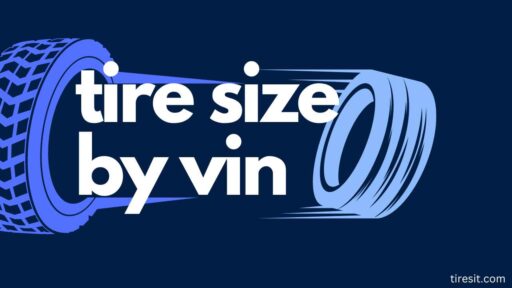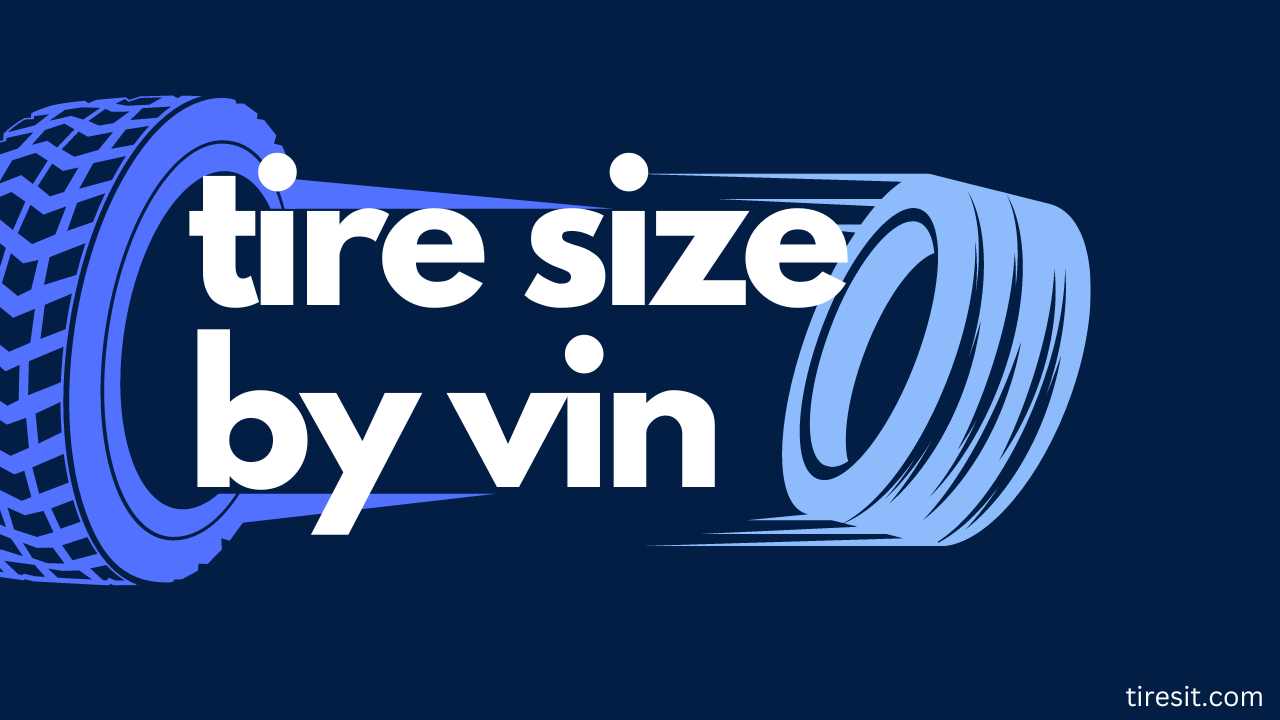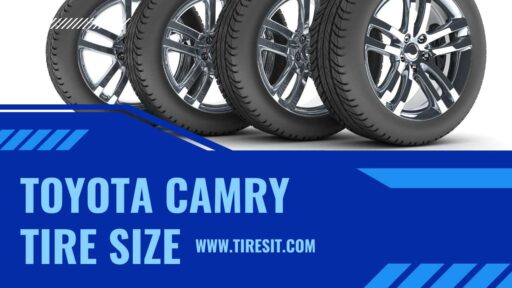Easily determine the correct Tire size by vin for your car with our VIN-based tool. Get precise details and suggestions on tire size by VIN on our site.
For car enthusiasts, vehicle owners, and mechanics alike, understanding tire size is as critical as any other aspect of vehicle maintenance or customization. Tires are what connect your vehicle to the road, dictating not just comfort and style, but also impacting safety, performance, and fuel efficiency. But, how do you ensure you’re choosing the right tire size? Enter the Vehicle Identification Number (VIN) – a unique code that holds the key to unlocking much-needed tire information.
The Secret Behind the VIN
Every car has a Vehicle Identification Number (VIN), which is akin to its DNA. This 17-character alphanumeric sequence not only reveals the vehicle’s manufacturing details, including year, make, and model, but it also encodes specific equipment specifications – tire size being one of them. By decoding the VIN, one can accurately determine the original tire size installed by the manufacturer, ensuring a perfect match for replacements or upgrades without the guesswork.
How to Decode Your VIN for Tire size by vin
Decoding a VIN to identify the correct tire size might seem like a daunting task, but it’s simpler than most people realize. The first step involves locating your vehicle’s VIN, which is typically found on the driver’s side dashboard, visible through the windshield, or on the vehicle registration documentation. Once you have your VIN, several online tools and databases allow you to input this number and instantly retrieve a wealth of information about your vehicle, including the original tire size specifications.
It’s important to note that while the VIN provides details on the car’s original specifications, car owners may choose to install a different tire size for various reasons, such as personal preference or improved performance. Therefore, verifying the current tire size directly on the tire sidewall and consulting with a professional before making any changes is advisable. This ensures optimal vehicle performance and safety on the road.
The Role of Tire Size in Vehicle Performance
The size of the tires on your vehicle plays a pivotal role in defining its handling, comfort, and efficiency. Larger tires, for example, can enhance the vehicle’s stability and grip on the road, potentially improving acceleration and braking performance. Conversely, smaller tires may improve fuel efficiency and provide a smoother ride by reducing the vehicle’s overall weight and changing its aerodynamics. Understanding the specifications encoded in your VIN allows you to make informed decisions that align with your driving needs and preferences, ensuring that any modifications or replacements contribute positively to your vehicle’s performance and safety.
Practical Tips for Decoding VIN for Tire Information
To efficiently decode your VIN for tire size information, consider following these practical steps:
- Use Reliable VIN Decoding Tools: There are numerous online VIN decoders available. Choose one that is reputable and widely recognized for accuracy. Auto manufacturers’ websites also often offer this service, providing detailed information specific to your vehicle.
- Consult Your Vehicle’s Owner Manual: In addition to using VIN decoding tools, your vehicle’s owner manual can be an invaluable resource. It usually contains details about the tire sizes that are compatible with your vehicle, along with other crucial information about tire pressure and maintenance.
- Understand Tire Codes: Learning how to read tire codes can be very beneficial. The tire size information decoded from the VIN is often represented in a standardized format (e.g., P215/65R15 95H) on the tire’s sidewall. Knowing what these numbers and letters mean can help you make sense of the tire size and its suitability for your vehicle.
- Reach Out to Professionals: If you’re unsure about the tire information you’ve decoded from the VIN or how it applies to your vehicle, consulting with a tire or automotive professional can provide clarity. They can verify the accuracy of your findings and recommend the best tire options based on your vehicle’s specifications and your driving habits.
- Check for Updates or Recalls: Occasionally, manufacturers may issue updates or recalls that affect tire specifications. It’s a good idea to check if there have been any notices or changes for your vehicle model that might influence the choice of tire size.
By carefully decoding the VIN for tire size and understanding how it impacts your vehicle’s performance, you can make informed decisions when purchasing tires, enhancing both your vehicle’s efficiency and your safety on the road.

Understanding the VIN
The VIN is more than just a series of random letters and numbers stamped on your vehicle’s body; it’s a 17-character identifier that provides a wealth of information about your car, including year, make, model, engine size, and, crucially, tire size. Typically, you can find the VIN on the dashboard on the driver’s side of the vehicle, visible through the windshield, as well as on the vehicle’s registration documents and insurance policy.
Demystifying the VIN’s Role in Determining Tire Size
Each segment of the VIN contains specific details about the vehicle. While the VIN itself does not directly spell out the tire size, manufacturers often use this number to reference against their databases to retrieve original equipment specifications, including the recommended tire size for your vehicle.
Decoding Tire size by vin
Tire size might seem like an arbitrary sequence of numbers and letters, but each component holds specific information about the tire’s dimensions that affect how it performs on your vehicle. For example, a tire marked “P225/50R16” tells you the type (“P” for passenger), the width in millimeters (225), the aspect ratio (50), the construction type (“R” for radial), and the wheel diameter (16 inches).
Tips for Choosing the Right Tire Size
Selecting the right tire size for your vehicle is crucial for ensuring optimal performance and safety. Once you have decoded your vehicle’s VIN and understand the recommended tire size, consider the following tips to make an informed choice:
- Evaluate Driving Conditions: Consider the primary driving conditions you encounter. Different tire sizes and types are suited for various environments. For instance, if you frequently drive on wet roads, look for tires that offer superior wet traction.
- Consider Performance Needs: If you are interested in enhancing your vehicle’s performance, larger tires might be the way to go for increased stability and grip. However, it’s essential to ensure that the tire size fits your vehicle without modifications that could affect its safety or legality.
- Check Compatibility: Even if tire size is suggested in your VIN’s decoded information, verify that it is compatible with your vehicle’s current model and modifications. Changes from the original specifications, such as suspension adjustments, can impact the suitable tire size.
- Balance Cost and Quality: While it might be tempting to choose cheaper tires, investing in high-quality tires from reputable brands can offer better longevity, performance, and safety. Remember, tires are a crucial factor in your vehicle’s overall performance and safety on the road.
- Read Reviews and Ratings: Look up customer reviews and professional ratings for tires within the recommended size to understand their performance, durability, and value. This can help narrow down your options and select the best tire for your needs.
- Understand the Implications of Changing Tire Size: If you are considering changing to a tire size different from your vehicle’s original specifications, understand how this might affect the vehicle’s speedometer accuracy, handling, and fuel efficiency. Consult with a professional to assess the viability and any required adjustments.
By following these tips and thoroughly understanding your vehicle’s tire size requirements, you can ensure that you select tires that will safely and effectively meet your driving needs. Remember, the right tire not only contributes to your vehicle’s performance and safety but can also enhance your driving experience.
Maintaining Your Tires for Maximum Performance
Regular maintenance of your tires is just as important as selecting the right size and type for your vehicle. Properly maintained tires can significantly extend their life, improve vehicle safety, and enhance fuel efficiency. Here are some essential tips for tire maintenance:
- Regular Inspections: Frequently check your tires for signs of wear, damage, or foreign objects lodged in the tread. Early detection of issues can prevent further damage and potential tire failure.
- Maintain Proper Tire Pressure: Underinflated or overinflated tires can lead to uneven wear, reduced fuel efficiency, and decreased control of the vehicle. Use a reliable tire pressure gauge to check your tires at least once a month and before long trips. Inflate them according to the manufacturer’s recommended pressure levels.
- Rotate Your Tires: Tire rotation helps ensure even tire wear by changing their positions on the vehicle. Most manufacturers recommend rotating tires every 5,000 to 8,000 miles. This practice can extend the life of your tires and improve their performance over time.
- Balancing and Alignment: Have your tires balanced and your vehicle’s alignment checked periodically, especially if you notice any unusual vibration or steering behaviors. Proper balance and alignment help prevent premature tire wear and maintain optimal driving conditions.
- Avoid Overloading: Exceeding your vehicle’s recommended load capacity puts additional stress on your tires and can lead to tire failure. Always adhere to the vehicle manufacturer’s load capacity guidelines.
By incorporating these maintenance practices, you can ensure that your tires remain in excellent condition, supporting the safety and efficiency of your vehicle. Remember, investing time in tire care can save you money in the long run and keep your journeys smooth and safe.
The Right Fit Matters
Choosing the correct tire size is not just about aesthetics; it’s about safety, performance, and efficiency. Incorrect tire sizes can lead to inaccurate speedometer readings and reduced handling quality, and may even interfere with the operation of safety features such as ABS. In contrast, the right tire size ensures optimal clearance, correct speed readings, and the proper carrying capacity.
Common Misconceptions and Mistakes
One common mistake is assuming that any tire size that fits the rim is suitable for the vehicle. However, even a small deviation from the manufacturer’s recommended tire size can significantly impact a vehicle’s dynamics. Another misconception is that the highest speed rating or the most rugged design equals the best tire choice, disregarding the manufacturer’s specifications which can result in poor performance or accelerated wear.
Where to Find Help
Deciphering the ideal tire size from your VIN and understanding tire codes may seem daunting, but numerous resources and professionals can assist. Most tire retailers have databases that match your VIN with the correct tire size, and many online tools allow you to input your VIN for tire size recommendations. Professional mechanics and tire specialists can also provide valuable advice tailored to your vehicle’s specific needs.
Frequently Asked Questions (FAQs)
Can I fit larger tires on my vehicle than what is recommended?
While fitting larger tires can offer benefits like improved grip and stability, it’s crucial to ensure they do not affect your vehicle’s safety or legality. Larger tires may require modifications to your vehicle that could impact handling, speedometer accuracy, and clearance. Always consult with a professional before making such changes to understand the implications fully.
How do I find out the recommended tire size for my vehicle?
The recommended tire size for your vehicle is typically found in the owner’s manual and on the information placard located on the driver’s side door jamb. Additionally, you can use your Vehicle Identification Number (VIN) at tire retailers or online tools that provide tire size recommendations based on the VIN.
How often should I replace my tires?
The lifespan of a tire depends on driving conditions, driving habits, and tire maintenance. Generally, tires should be inspected regularly and might need to be replaced every six years, regardless of tread wear. Always monitor for signs of wear and damage, and consult with a tire specialist to assess when replacement is necessary.
What is tire rotation and why is it necessary?
Tire rotation involves changing the position of a vehicle’s tires to ensure even tire wear. It’s necessary because front and rear tires wear differently due to steering and load-bearing differences. Rotating them helps extend the life of your tires, improve handling, and maintain fuel efficiency. Most manufacturers recommend rotating tires every 5,000 to 8,000 miles.
What does it mean when a tire is overinflated or underinflated?
An overinflated tire has too much air pressure, which reduces the amount of tire in contact with the road, leading to decreased traction and uneven wear. Underinflated tires have too little air pressure, increasing the tire’s surface area in contact with the road, which can cause overheating, premature wear, and reduced fuel efficiency. Maintaining proper tire pressure according to the manufacturer’s recommendation is essential for optimal tire performance and safety.
How does changing the tire size affect my vehicle’s speedometer and odometer?
Changing the tire size from the OEM (Original Equipment Manufacturer) specifications can lead to inaccuracies in speedometer and odometer readings because these devices are calibrated based on the rotation of the factory-specified tire size. Larger tires will make fewer rotations to cover the same distance, causing the speedometer to show a slower speed than the vehicle is actually going, and vice versa for smaller tires. Calibration adjustments may be required if you change tire sizes.
What is the significance of tire speed ratings and tire load indexes?
Tire speed ratings indicate the maximum speed a tire can safely sustain over time, while the tire load index signifies the maximum weight a tire can carry. Choosing a tire with an appropriate speed rating and load index for your vehicle is crucial for maintaining performance, safety, and durability. Ignoring these specifications can lead to tire failure or reduced vehicle handling and safety.
Conclusion of Tire size by vin
In the intricate world of vehicle maintenance and customization, Tire size by vin plays a pivotal role that goes beyond mere numbers. By understanding how to decode this size through your VIN, you can ensure your vehicle operates safely, performs optimally, and runs efficiently.
Whether you’re a car enthusiast looking to upgrade, a new vehicle owner aiming to maintain, or a seasoned mechanic, respecting the specifications set by the vehicle manufacturer ensures the longevity and safety of the vehicle you’re working on. Remember, the right tire size is one of the critical components of a well-tuned ride.





